Vladislav Orekhov
Department of Chemistry and Molecular Biology, Swedish NMR Centre, University of Gothenburg, Sweden
Towards Ultimate NMR Resolution with Deep Learning
Feb 28, 2025



Abstract:In multidimensional NMR spectroscopy, practical resolution is defined as the ability to distinguish and accurately determine signal positions against a background of overlapping peaks, thermal noise, and spectral artifacts. In the pursuit of ultimate resolution, we introduce Peak Probability Presentations ($P^3$)- a statistical spectral representation that assigns a probability to each spectral point, indicating the likelihood of a peak maximum occurring at that location. The mapping between the spectrum and $P^3$ is achieved using MR-Ai, a physics-inspired deep learning neural network architecture, designed to handle multidimensional NMR spectra. Furthermore, we demonstrate that MR-Ai enables coprocessing of multiple spectra, facilitating direct information exchange between datasets. This feature significantly enhances spectral quality, particularly in cases of highly sparse sampling. Performance of MR-Ai and high value of the $P^3$ are demonstrated on the synthetic data and spectra of Tau, MATL1, Calmodulin, and several other proteins.
Beyond traditional Magnetic Resonance processing with Artificial Intelligence
May 13, 2024Abstract:Smart signal processing approaches using Artificial Intelligence are gaining momentum in NMR applications. In this study, we demonstrate that AI offers new opportunities beyond tasks addressed by traditional techniques. We developed and trained several artificial neural networks in our new toolbox Magnetic Resonance with Artificial intelligence (MR-Ai) to solve three "impossible" problems: quadrature detection using only Echo (or Anti-Echo) modulation from the traditional Echo/Anti-Echo scheme; accessing uncertainty of signal intensity at each point in a spectrum processed by any given method; and defining a reference-free score for quantitative access of NMR spectrum quality. Our findings highlight the potential of AI techniques to revolutionize NMR processing and analysis.
Resolution enhancement of NMR by decoupling with low-rank Hankel model
Dec 02, 2022Abstract:Nuclear magnetic resonance (NMR) spectroscopy has become a formidable tool for biochemistry and medicine. Although J-coupling carries essential structural information it may also limit the spectral resolution. Homonuclear decoupling remains a challenging problem. In this work, we introduce a new approach that uses a specific coupling value as prior knowledge, and Hankel property of exponential NMR signal to achieve the broadband heteronuclear decoupling using the low-rank method. Our results on synthetic and realistic HMQC spectra demonstrate that the proposed method not only effectively enhances resolution by decoupling, but also maintains sensitivity and suppresses spectral artefacts. The approach can be combined with the non-uniform sampling, which means that the resolution can be further improved without any extra acquisition time
Accelerated NMR Spectroscopy: Merge Optimization with Deep Learning
Jan 02, 2021
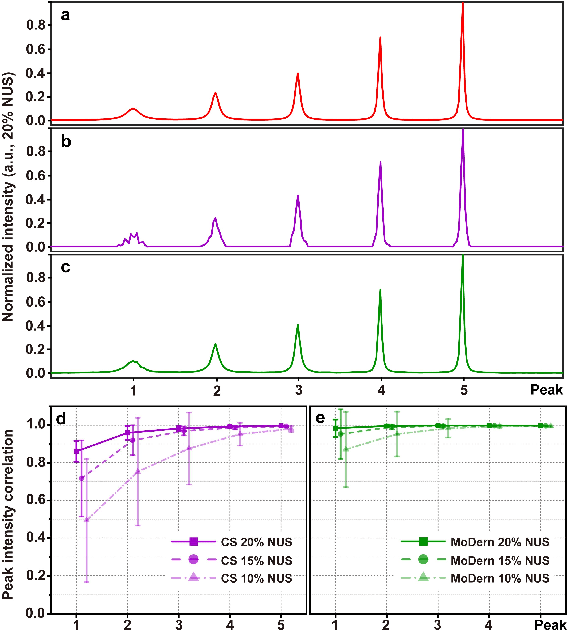
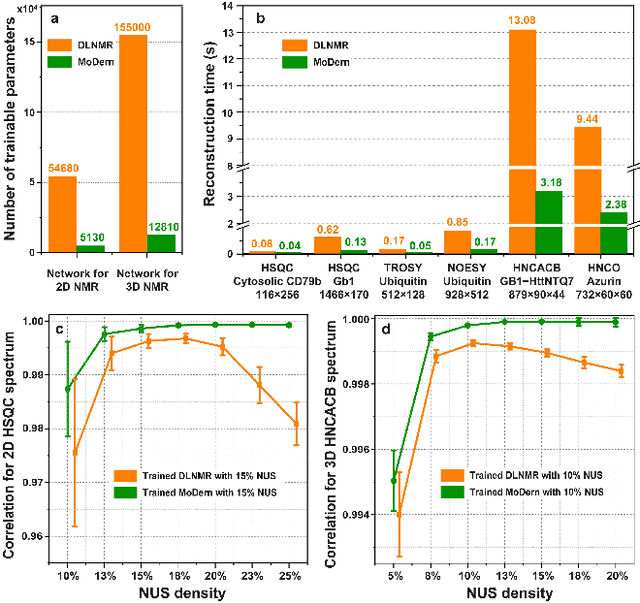
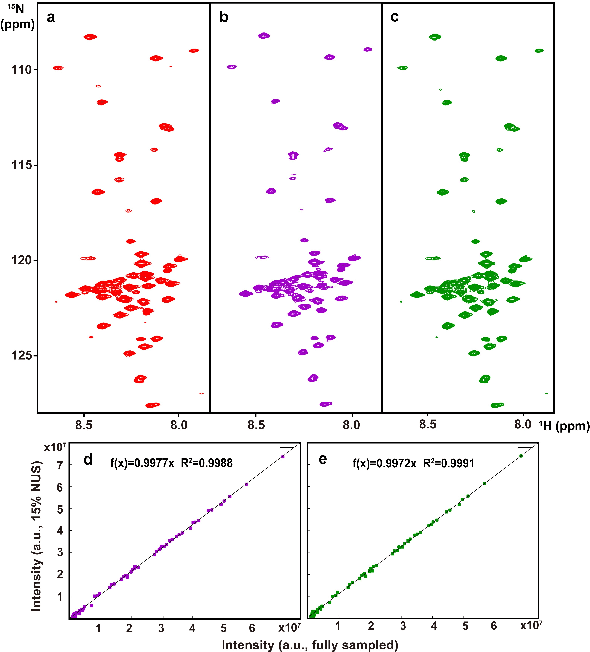
Abstract:Multi-dimensional NMR spectroscopy is an invaluable biophysical tool in studies of structure, interactions, and dynamics of large molecules like proteins and nuclear acids. Non-uniform sampling is a powerful approach for shortening measurement time and increasing spectra resolution. Several methods have been established for spectra reconstruction from the undersampled data, typical approaches include model-based optimization and data-driven deep learning. The former is well theoretically grounded and provides high-quality spectra, while the latter has a huge advantage in reconstruction time potential and push further limits of spectra quality and analysis. Combining the merits of the two, we propose a model-inspired deep learning, for reliable, high-quality, and ultra-fast spectra reconstruction, exemplified by multi-dimensional spectra of several representative proteins. We demonstrate that the proposed network needs very few parameters, and shows very high robustness in respect to dissimilarity of the training and target data in the spectra size, type, and sampling level. This work can be considered as a proof-of-concept of merging optimization with deep learning in NMR spectroscopy.
Review and Prospect: Deep Learning in Nuclear Magnetic Resonance Spectroscopy
Jan 13, 2020



Abstract:Since the concept of deep learning (DL) was formally proposed in 2006, it had a major impact on academic research and industry. Nowadays, DL provides an unprecedented way to analyze and process data with demonstrated great results in computer vision, medical imaging, natural language processing, etc. In this Minireview, we summarize applications of DL in nuclear magnetic resonance (NMR) spectroscopy and outline a perspective for DL as entirely new approaches that is likely to transform NMR spectroscopy into a much more efficient and powerful technique in chemistry and life science.
Accelerated Nuclear Magnetic Resonance Spectroscopy with Deep Learning
May 14, 2019
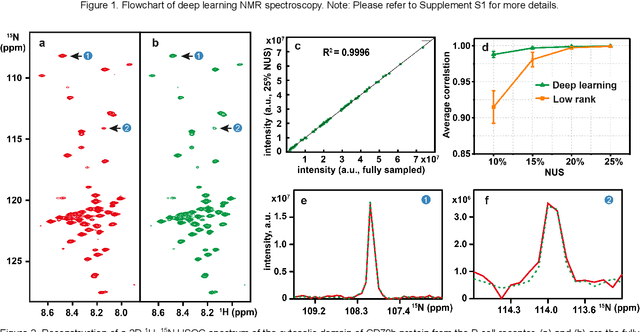
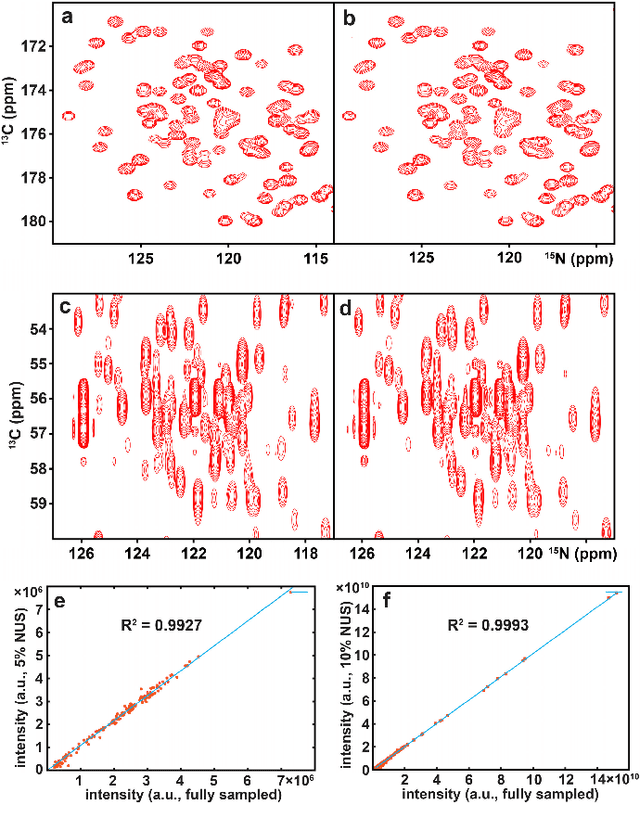

Abstract:Nuclear magnetic resonance (NMR) spectroscopy serves as an indispensable tool in chemistry and biology but often suffers from long experimental time. We present a proof-of-concept of application of deep learning and neural network for high-quality, reliable, and very fast NMR spectra reconstruction from limited experimental data. We show that the neural network training can be achieved using solely synthetic NMR signal, which lifts the prohibiting demand for a large volume of realistic training data usually required in the deep learning approach.
 Add to Chrome
Add to Chrome Add to Firefox
Add to Firefox Add to Edge
Add to Edge